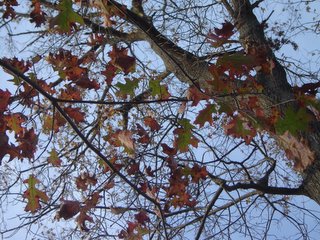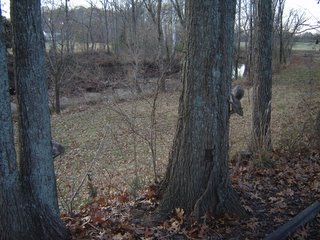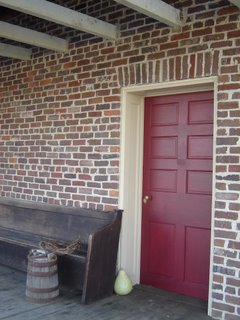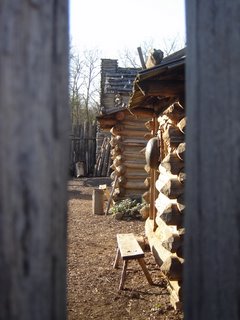Today I gave my first tour of Second Harvest Food Bank. Considering my location on the staff org chart and my short length of employment at SHFB, you get an idea of how many other staff must have been unavailable for them to get allllll the way to ME as a tour guide.
First, you should know that we have quite a facility. We look nothing like your church food pantry, though that is what every tour group expects to see. Distributing seven million pounds of food each year to half the state of Tennessee requires a little more than a back room with a few shelves and barely ambulatory;) ladies.
A group of thirteen fifth and sixth grade Girl Scouts came at 2:00pm. My supervisor gave this tour as I tagged along to learn the path for the tour I was in charge of at 3:30pm. As we walked around, the girls paid almost zero attention. They thought it was dumb that they had to wear nametags. They talked to each other. They wandered from the group. They played with each other's hair. They played with their clothing, most of which I doubt met the school dress code. They sat on railings. They stepped on empty pallets. They asked their troop leaders, who were busy chatting with each other, why they even had to be there. I spent more time worrying that one of them would pull a box onto her head than I did learning how to guide a tour. They asked almost no questions, because after all, they hadn't paid enough attention to need clarification on anything.
Dreading the 3:30 tour group, I waited downstairs ready with my cheat-sheet-notes prepared to endure another group of the same type. However... in walked the most well-behaved children on the planet. Twenty 2nd, 3rd, and 4th graders filed into the lobby without a peep. They neatly printed their own names on sticky name tags, which they wore with pride. A school administrator asked my name, then turned to the students and said, "Ms. Laura is in charge while we are here. Listen to what she says. Remember to walk behind her, not in front of her, because she knows where we are going and what is safe."
We started in the Culinary Arts Center. "This is our kitchen where Mr. Mark, our chef, cooks all sorts of special food." Mr. Mark went on to tell the students how he does cooking demonstrations, food safety classes, and catering. The kids thought he was really cool because he cooks dinner for the Titans coaches three nights a week.
Then we went to the Emergency Food Box room. "Have you ever done a food drive at your school or church?" (Yeeees.) Well this is where all that food ends up. These volunteers sort it into stacks of peanut butter, rice, vegetables, etc. Then they help us pack it all into these boxes. (They ooh and ahh over the conveyor belt.) Sometimes people are hungry and they can't afford to go to the grocery store. They can go to a community center near their house and get a box of food like this." The students' hands shot up to ask a plethora of questions like, "What if I know someone who needs food?" "How much food can one person take?" "Is it free?" "Do you feed more kids or more adults?" "Do you deliver the food?" "What happens if you run out of food in this room?" They even asked follow-up questions to my answers.
Then we went into the warehouse. "Do you see all these boxes of food and stacks of cans? Most of this food is a mistake! How many of you like to cook at home? (They all smiled and raised their hands.) How many of you have ever made a mistake when you were cooking? (A few kids told me what they accidentally did.) What did you do with the food? (Threw it away, fed it to the dog, etc.) Well, when food manufacturers make mistakes, we love it! Sometimes they make too much of a certain food, or stores order the wrong amount, or trucks deliver to the wrong places. One time, the cereal factory that makes Froot Loops accidentally spelled something wrong on the box. They produced thousands of boxes with mistakes before they realized it. But instead of throwing away those boxes of cereal, they gave them all to us!"
On to the Project Preserve room. "In this room, we take raw ingredients like fresh veggies and meat and we make beef stew. We can make macaroni and cheese, chicken and rice - just about anything. We cook everything, then seal it up in plastic bags or cans before we ship it out to other places." A second grader raised his hand to ask in amazement, "So, when you make soup in here, do you guys get to put the Campbell's Soup label on the can?" A great question - and the answer is that Second Harvest puts its own label on the cans of food we produce. We are the only food bank in the country to do so. We sell this product to other food banks as a source of revenue for local programs.
Then to the cold storage. This is every kid's favorite part. We walked through a giant refrigerated room and I told them what we keep in there. I asked if they wanted to be colder, and they giggled and shivered as we took a quick walk in and out of the freezer room, which is 10 degrees below zero.
Back in the regular warehouse, we watched a worker forklift a full pallet of boxes waaaaay up to the top shelf. The students were SURE he was going to drop it. They applauded and cheered when he finished.
Then a student said, "In the summer, I go to a community center and they feed us breakfast. Do you guys do anything like that in the summer?" I said, "Actually, the food you eat at that site come from right here in this building. It is part of our Kids Cafe program." Suddenly all the little voices said, "Kids Cafe! Yeah, yeah! I go to that too! The food is good and the people are nice and its so cool and I love it!"
We wrapped up the tour with group pictures. I even gave them cool Second Harvest magnets that are shaped like plates, forks, spoons, and knives. One kid said, "Can I have another one so I can put it on my grandma's fridge? She'll want to know about this."
I was nearly hugged to death as they left. That second group made my day. I didn't think there were any students left in the world who were as well behaved, curious, thoughtful, and respectful as they were.














